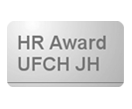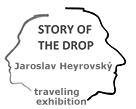Remembering the 60th Anniversary of Jaroslav Heyrovský’s Nobel Prize
J. Heyrovský Institute of Physical Chemistry, 7 November 2019
60 years ago the Czech scientist, Professor Jaroslav Heyrovský, was awarded the Nobel Prize, making him the sole recipient for science and one of only two Czech laureates in the history of the prize. The prize was awarded for the discovery of a new analytical method – polarography, from which most modern electro-chemical methods have evolved. In celebration of this occasion the J. Heyrovský Institute of Physical Chemistry will hold a ceremonial meeting on 11 November to commemorate this event, which was of such great significance for the Czech scientific community, with very special guests including the chairwoman of the Czech Academy of Sciences Eva Zažímalová and the Charles University Rector’s Board. The celebration will be followed up by the opening of the new Department of Nanocatalysis, funded via the prestigious ERA Chair grant.
“The success of Professor Heyrovský is not just an opportunity for celebration; it is also a reminder of commitment. Following his legacy, our institute has committed to strive for scientific excellence. It is not easy at all to produce top-level results in basic research. You need to be fully focused and even maintain the commitment for years in some cases. However, this long, meticulous work is the only way to reach the understanding of nature,” says Professor Martin Hof, Director of the J. Heyrovský Institute of Physical Chemistry.
Looking back at the legacy of Professor Heyrovský as well as outlining the modern electrochemical approaches in both basic and applied research, which the scientists at the Heyrovský institute have been engaged in, will comprise the agenda on 11 November at the premises of this prestigious scientific institute. The celebratory programme will also include short scientific contributions related to the utilisation of electrochemistry in current science, with connections to practical use:
Prof. Jiří Ludvík: Molecular electrochemistry in fundamental research
Molecular electrochemistry enables the study of basic properties of newly prepared compounds on molecular to atomic levels. This will be illustrated in three examples: In the case of calixarenes, this pertains to the development of specific sensors, a second molecular group exhibits the “Singlet Fission” effect, which improves the efficiency of solar power cells, and lastly, titanocenes are molecules with significant anti-carcinogenic effects.
Doc. Petr Krtil: Rational Electrocatalysis for Renewable Electricity Storage
This seminar shall present the programme of rational development of catalysers allowing for replacement of fossil fuels in industry and traffic. The principles of rational design shall be explained in an example of anode development intended for hydrogen production via water electrolysis. The status of the programme shall also be put into the context of pan-European initiatives.
Polarography is still a viable electroanalytical method, which utilises the unique properties of mercury drops as electrodes and the current measured in relation to the potential put in describes both the nature and properties of the analysed molecules and their concentration, as well as the reactions taking place, their kinetics and mechanisms. Thanks to increased usage of electrode materials and the development of electronics and computer technology, the combination resulted in a wide spectrum of electrochemical method focuses (apart from analytical chemistry), from electrosynthesis, studies of catalysis, biological redox systems, conversion and storage of power from renewable resources, utilisation of electrochemistry in medicinal and pharmacological applications to electrochemical research of nano-materials and studies of electron distribution across individual molecules.
Professor Heyrovský attained many prizes over the course of his life. He became a member of the London Royal Society and received a number of honorary doctorates from world-renowned universities and science academy memberships; on 10 December 1959 in Stockholm, he was awarded the Nobel Prize in Chemistry. In 1950, he became the director of the newly established Polarographic Institute, now the J. Heyrovský Institute of Physical Chemistry, a position he held until 73 years of age.
“I am honoured to be among the successors of Prof Heyrovský in charge of the institute. Today's era, with their focus on quick gain, brings its specifics, which we encounter in science as well. However, moral values must remain the first priority at all cost, which is what we perceive as one of the most important legacies of Professor Heyrovský,” said Professor Martin Hof, Director of the J. Heyrovský Institute of Physical Chemistry.
In relation to the celebration, the institute shall present the Story of the Drop exhibition, which charts the genesis and development of polarography; the exhibition will be accessible to the public throughout the afternoon on the day of the celebration from 1 to 7 p.m. The exposition will present a diverse range of historical information, photographic material, as well as various types of devices, polarographs and their gradual development, from the earliest versions from the 30s to computerised polarographs from the 90s. The current polarographic instruments (and electrochemical equipment in general) are available for viewing on request directly at the laboratories.
On the same day, 11 November, a ceremonial opening of the new Department of Nanocatalysis laboratories will take place as part of the J. Heyrovský Chair project. The J. Heyrovský Chair project is funded via the prestigious ERA Chair grant totalling more than CZK 60 million.
“The goal of this type of research project by the European Research Area and Innovation Committee is to attract excellent scientific personalities with managerial skills in order to develop new centres of excellence,“ said Martin Hof, Director of the J. Heyrovský Institute of Physical Chemistry.
The position of the head of the new department was accepted by Dr Štefan Vajda, who had previously been with the American Argonne National Laboratories. The Nanocatalysis department, of which he is now in charge, will soon be completed by unique state-of-the-art devices which he himself designed and managed to acquire from his previous place of work in USA. He will present his scientific research as part of the m programme in his lecture on Catalysis by Size-Selected Clusters.
“Despite their robust frame with a total mass exceeding six tonnes, these machines offer unique possibilities when it comes to researching the most subtle particles, which are completely invisible to the naked eye,” confirms Štefan Vajda, adding that the exceptional equipment will allow scientists to expand their scientific knowledge about nanotechnology and nanomaterials, with possible utilisation in both industry and environmental protection.
The new department shall connect several traditional departments of the Heyrovský institute: catalysis, electrochemistry, biochemistry, gaseous stage physical chemistry, cluster&nanoparticle chemistry and physics, surface research and computational chemistry.
Author: Daniel Jakeš, J. Heyrovský Institute of Physical Chemistry, Czech Academy of Sciences




























